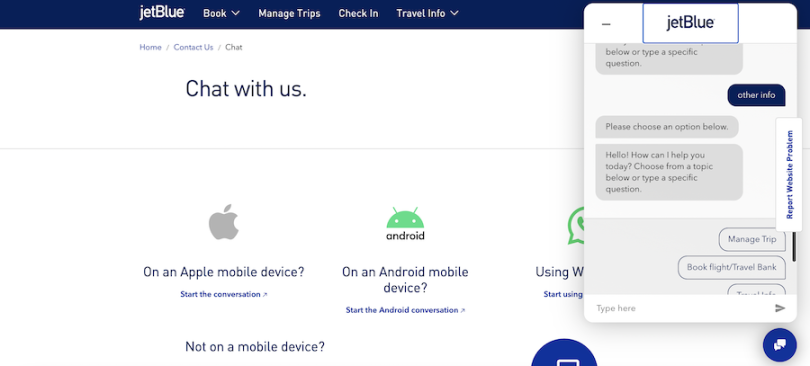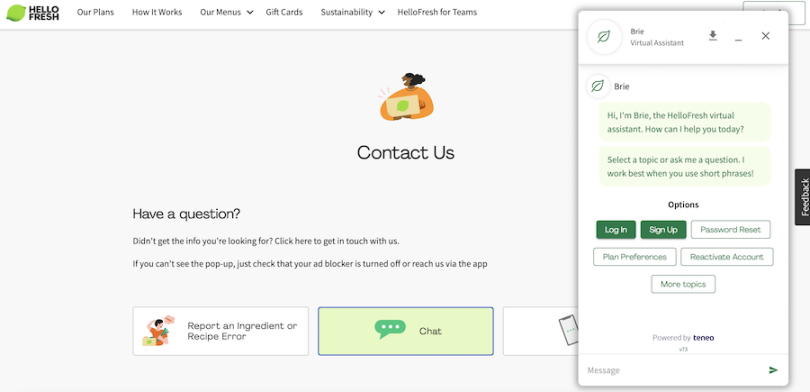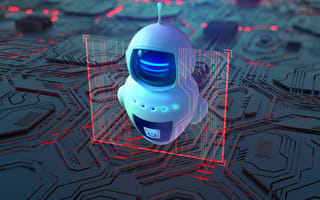A chatbot is an automated computer program capable of simulating human conversation. Using artificial intelligence, chatbots can understand what a human user says and respond in a fluent and cogent way. This makes them particularly useful as customer support representatives and virtual assistants.
Chatbots can be simple interfaces that answer only specific questions with single-line responses, or sophisticated programs that evolve and deliver increasing levels of personalization the more they gather and process information.
Chatbot Definition
A chatbot is an automated computer program that can simulate human conversation. Using artificial intelligence (AI), chatbots can understand what a human user says and respond to them in a coherent way.
No matter the format or size of the chatbot, “the goal is to get the customer to self-serve,” Maria Aretoulaki, the head of voice and conversational AI product development company GlobalLogic, told Built In. Chatbots make it easier for users to find the information they need by automatically providing responses to their requests or questions — be it audio or text — without the need for human intervention.
How Do Chatbots Work?
Chatbots rely on machine learning and deep learning — components of AI with some nuanced differences — to develop a more granular knowledge and continue learning as they’re exposed to more data in the form of human language. This improves their ability to anticipate users’ needs and formulate the correct response over time.
“The best chatbots are ones that can understand your intent and do an action,” Rob LoCascio, the founder and CEO of conversational AI company LivePerson, told Built In. “That’s really the yin and yang of a chatbot. It’s the intent — what do I want? And then the action.”
Some more sophisticated chatbots are powered by a neural network, which is a mathematical system that learns skills based on the patterns and relationships it finds in large quantities of digital data. Neural networks are good at a lot of things, including mimicking human language in what are called large language models.
AI companies are rolling out neural-network-powered chatbots that can carry out real-time conversations with humans. These are what former Google software engineer Daniel De Freitas calls “open-ended” chatbots, meaning that they can talk about any subject.
“Open-ended means everything goes,” De Freitas told Built In. These chatbots are good at an “uncountable number of things,” thanks largely to an immense amount of both training data and computing power.
De Freitas created one of the very first of these kinds of chatbots, LaMDA, which has since been followed up by large language models like ChatGPT, Bard, Bing Chat and others. He now heads a company called Character.AI, whose open-ended chatbot has garnered the financial backing of major VC firms like Andreessen Horowitz.
Chatbots vs. Conversational AI
Some chatbots are a subset of conversational AI, a broad form of artificial intelligence that enables a dialogue between people and computers. These conversational AI chatbots use artificial intelligence to replicate human dialogue and can handle everything from open-ended questions to super specific requests.
Other chatbots don’t use artificial intelligence at all. Instead, they rely on a series of pre-set answers that only work for a limited set of predetermined statements and questions.
History of Chatbots
For decades, chatbots were exclusively text-based, and were programmed to reply to only a limited set of statements and questions with answers that had been pre-written by human developers.
One of the earliest known examples of this is ELIZA, created by MIT professor Joseph Weizenbaum in the 1960s. With its simple design of predetermined statements, paired with keyword and pattern matching, ELIZA was able to mimic the conversational patterns of psychotherapists, and even trick some users into thinking it was just as intelligent as a human.
Over time, chatbots began integrating more sophisticated forms of artificial intelligence like natural language processing and natural language generation, allowing users to experience them in a more conversational way, as opposed to just simple Q&A.
Now, chatbots are sophisticated enough to recognize natural, spontaneous speech, and are more contextually aware.
Types of Chatbots
There are many different types of chatbots — some are limited to just a menu of questions and answers, some recognize keywords, and some communicate via voice inputs and outputs. But they can all be placed into one of two buckets: Rules-based and predictive.
Rules-Based Chatbots
Rules-based chatbots hold structured conversations with users, similar to interactive FAQs. They can handle common questions about a particular product or service, pricing, store hours and more. They can also handle simple, repetitive transactions such as asking customers for their feedback or logging a request.
Rules-based chatbots are commonly used in more customer service-oriented tasks. They’re also useful in internal business operations since they can handle repetitive jobs such as onboarding new employees or answering questions on specific company policies.
Predictive Chatbots
Predictive chatbots are capable of sophisticated and nuanced conversations thanks to its use of natural language processing, natural language generation and other elements of AI. They’re good at understanding context, and can anticipate what a user might need next.
Some of these chatbots are more open-ended, like De Freitas’ Character.AI; or Kuki, which has managed to beat the Loebner Prize Turing Test, an annual competition to determine the world’s most human-like chatbot, five times. Others are more task-oriented and limited in scope.
“Chatbots kind of run the spectrum,” Joseph Gallagher, the VP of product at mental health-focused conversational AI startup Woebot Health, told Built In. “There are some chatbots out there now that are conversational in the absence of a goal. They’re just there to let people chit-chat,” he continued. Some are “very, very transactional,” and others are “conversational with an overarching goal.”
Woebot is a good example of this. The chatbot is conversational, and is designed to provide mental health treatment in the same ways a human therapist might. But, unlike a lot of chatbots these days, Woebot doesn’t use large language models, and its text is not automatically generated. Rather, its responses are “artisanally crafted,” as Gallagher put it, ahead of time by its team of human conversational designers, who range from English graduates to clinical psychologists. It only uses AI to deduce the intent of a user in real time, so it can properly decide what pre-written response to give.
“For us, it’s about finding the right tone and personality, and bringing people to a place where they’re not only willing but they want to discuss their mental health and the challenges they face,” Gallagher said. “What you really need is to build a relationship.”
Benefits of Chatbots
Whether it’s to improve customer experience or boost operational efficiency, chatbots are quite useful, and they offer a variety of benefits for both businesses and individual users.
Make It Easy for Humans to Ask Questions
The ability to foster this feeling of personal relationship is perhaps one of the biggest, most profound benefits of chatbots.
“Chatbots, if they’re good, allow us to have a conversation,” LoCascio said. “The chatbot is basically just reinforcing personalization in a person’s brain that this thing is listening to me, it understands me, and is responding to me. And I think that’s the greatest benefit to this technology, is that it feels very personal.”
At the same time, chatbots don’t judge, which can also be important. So, they provide the personal connection people want, without the judgment that can come with talking to people — particularly when it is a sensitive subject like mental health, or healthcare-related questions.
Boost Operational Efficiency
Even the less sophisticated chatbots that aren’t capable of complex conversations are able to automate a lot of the rote or mundane tasks that humans don’t necessarily need to be doing.
For example, an e-commerce company may want to have a chatbot on its website to answer users’ questions about specific products or services. Or an HR department at a company may want to implement a chatbot so that employees have 24/7 access to information about benefits and company policies — all without having to have a human on call.
That said, Aretoulaki of GlobalLogic says it is important to have humans involved in the design and training of a chatbot — both so that the tool actually serves its purpose, and so that it is built ethically and with as little bias as possible.
Improve Brand Recognition and Loyalty
Beyond these more practical benefits, chatbots have the long-term potential of improving customer engagement, and even brand recognition and loyalty. Going forward, Gallagher expects that the more branded chatbots come on the scene, the more people’s relationships with those brands will be dictated by that chatbot. The way a particular brand’s chatbot communicates — the language it uses, its tone — will become a part of a brand’s reputation with consumers.
“A lot of the people who are using, or proposing to use, this technology have existing businesses. The question isn’t so much about consumers’ relationship to this technology, it’s about consumers’ relationship to companies who use this technology. How does that change?” Gallagher said.
Challenges of Chatbots
Chatbots are by no means a perfect piece of technology, and they still come with plenty of challenges.
Require Lots of Training Data
For many, the biggest challenge of having a chatbot occurs before the chatbot is even built: Acquiring enough training data.
Chatbots often require vast amounts of data to ensure accuracy. Large companies like Google, Microsoft and OpenAI have virtually unlimited computing power, and are capable of tapping into unlimited volumes of data across the web. But most other businesses are much more constrained. Their proprietary data on customers and the business — which are necessary if they want the chatbot to offer accurate answers — is not accessible online. Rather, it resides in corporate data centers, in different formats. Using it effectively looks more like an archaeological excavation than a broad sweep of the internet.
Can Be Difficult to Choose the Right One
Figuring out exactly what kind of chatbot a business should make can also be challenging.
“Part of the chatbot design should be to determine whether you need one, which type you should use, for which tasks, what you should automate, and where and when,” Aretoulaki said. “How sophisticated do you want it to be? Should it only be predetermined options where you press buttons? Or will you let the customer express themselves in a free-text form? This of course is more tricky and therefore more dangerous if you don’t understand it.”
Have Quality Issues
Once a chatbot is made, it is far from perfect. For one, chatbots (particularly those that use generative AI to form responses) get things wrong all the time. They can fabricate information, and format it in a way that is so eloquent that it is difficult to spot.
Chatbots also remain fairly unintelligent — meaning that, despite ongoing fears, chatbots cannot fully replace human jobs (yet). Although the technology has come a long way, chatbots are not sentient or conscious. They don’t understand the complexities of life, or what it means to be human. And at times this can be apparent in the quality of its outputs.
“I don’t think this thing will replace us. I think it’ll make us work differently.”
“[This technology] is not there yet, in terms of understanding how to be human. It doesn’t have our je ne sais quoi. Whatever we have as humans that makes us unique and interesting,” Jason Gilbert, a multi-modal designer at Intuition Robotics told Built In. “I don’t think this thing will replace us. I think it’ll make us work differently. It’ll give us the tools to work differently, to work more efficiently — at higher outcomes and higher outputs.”
Still, as with all of artificial intelligence, chatbots are continuing to evolve fast. And with the release of ChatGPT’s API, along with the falling costs of access to large language models, there will likely be a proliferation of chatbots for businesses big and small.
“This is just the beginning,” De Freitas of Character.AI said, noting that chatbots are going to get a lot more intelligent. “It will become a greater and greater part of people’s lives.”
Examples of Chatbots
IBM — Watson Assistant
IBM features Watson Assistant on its website as an easy way to address customers’ basic questions. Combining natural language processing, deep learning and machine learning, Watson can aid customers with interactive demos, reaching IBM team members and explaining what Watson is.
Domino’s — Dom
To personalize its digital customer experience, Domino’s supports buyers with its ordering assistant bot Dom. Dom can process new orders, find previous orders and provide tracking information for customers. The assistant asks general questions to guide customers through each conversation.

JetBlue — Multi-Platform Chat Service
JetBlue developed a multi-platform chatbot for travelers looking to make last-minute changes or double-check information. While JetBlue’s chatbot can book flights and review trip details, it can also address more specific questions about topics like safety and health requirements.
Zoho — Answer Bot
Designed with sales teams in mind, Zoho’s Answer Bot operates as a 24/7 virtual agent that addresses customer questions and concerns. Besides jump-starting conversations and making small talk, Answer Bot can also send helpful articles and resources to customers from a client’s database.
Benefits Data Trust — Wyatt
Working with the College Board, Benefits Data Trust helped build Wyatt in an effort to raise the number of college students receiving financial aid. Wyatt applies AI and NLP to understand students’ questions and sharpen its responses over time.
Lemonade — Maya
To increase the efficiency of its customer experience team, insurtech company Lemonade relies on its AI chatbot Maya for handling various inquiries around the clock. Maya can assist customers with policy changes, coverage additions, checking claims and other insurance tasks.
Amtrak — Julie
Julie has been a mainstay at Amtrak since its days as a phone assistant, but it now serves customers as a chatbot on the Amtrak site. With a comprehensive knowledge of Amtrek’s site, Julie can sift through content and locate pages that can best answer customers’ questions.
Duolingo — Explain My Answer and Roleplay
Duolingo users can gain access to the Explain My Answer and Roleplay features when purchasing the Duolingo Max subscription. The Explain My Answer tool gives users a deeper explanation about their answers and why they’re correct or incorrect. Roleplay enables users to apply what they’ve learned by engaging in conversations with characters on the app.

HelloFresh — Brie
HelloFresh’s customer support chatbot Brie is built to handle a broad range of topics. Besides basic tasks like resetting passwords and reactivating accounts, Brie can answer questions about sales taxes, promotions, website errors and more specific queries.
Lark Health — Digital Coach
To deliver 24/7 support to users, Lark Health has crafted a digital health coach that can offer personalized advice. The Lark app tracks patient data, which the digital health coach then uses to create customized tips. Users can access this coaching tool for advice on losing weight, eating healthier, achieving better sleep and other topics.




